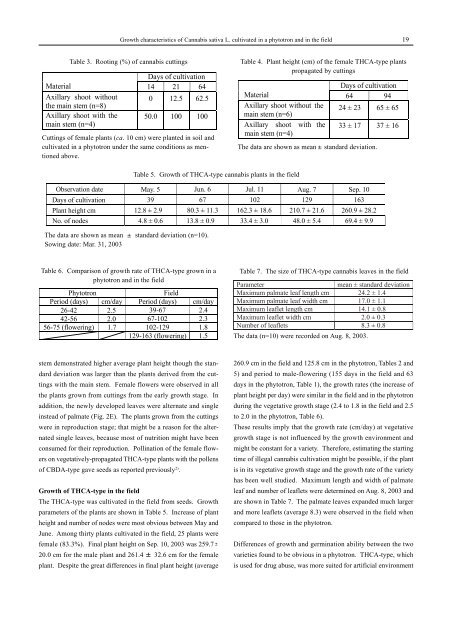Growth characteristics of Cannabis sativa L. cultivated in a ... - NIHS
Growth characteristics of Cannabis sativa L. cultivated in a ... - NIHS
Growth characteristics of Cannabis sativa L. cultivated in a ... - NIHS
You also want an ePaper? Increase the reach of your titles
YUMPU automatically turns print PDFs into web optimized ePapers that Google loves.
<strong>Growth</strong> <strong>characteristics</strong> <strong>of</strong> <strong>Cannabis</strong> <strong>sativa</strong> L. <strong>cultivated</strong> <strong>in</strong> a phytotron and <strong>in</strong> the field<br />
19<br />
Table 3. Root<strong>in</strong>g (%) <strong>of</strong> cannabis cutt<strong>in</strong>gs<br />
Table 4. Plant height (cm) <strong>of</strong> the female THCA-type plants<br />
propagated by cutt<strong>in</strong>gs<br />
Cutt<strong>in</strong>gs <strong>of</strong> female plants (ca. 10 cm) were planted <strong>in</strong> soil and<br />
<strong>cultivated</strong> <strong>in</strong> a phytotron under the same conditions as mentioned<br />
above.<br />
The data are shown as mean standard deviation.<br />
Table 5. <strong>Growth</strong> <strong>of</strong> THCA-type cannabis plants <strong>in</strong> the field<br />
The data are shown as mean standard deviation (n=10).<br />
Sow<strong>in</strong>g date: Mar. 31, 2003<br />
Table 6. Comparison <strong>of</strong> growth rate <strong>of</strong> THCA-type grown <strong>in</strong> a<br />
phytotron and <strong>in</strong> the field<br />
Table 7. The size <strong>of</strong> THCA-type cannabis leaves <strong>in</strong> the field<br />
The data (n=10) were recorded on Aug. 8, 2003.<br />
stem demonstrated higher average plant height though the standard<br />
deviation was larger than the plants derived from the cutt<strong>in</strong>gs<br />
with the ma<strong>in</strong> stem. Female flowers were observed <strong>in</strong> all<br />
the plants grown from cutt<strong>in</strong>gs from the early growth stage. In<br />
addition, the newly developed leaves were alternate and s<strong>in</strong>gle<br />
<strong>in</strong>stead <strong>of</strong> palmate (Fig. 2E). The plants grown from the cutt<strong>in</strong>gs<br />
were <strong>in</strong> reproduction stage; that might be a reason for the alternated<br />
s<strong>in</strong>gle leaves, because most <strong>of</strong> nutrition might have been<br />
consumed for their reproduction. Poll<strong>in</strong>ation <strong>of</strong> the female flowers<br />
on vegetatively-propagated THCA-type plants with the pollens<br />
<strong>of</strong> CBDA-type gave seeds as reported previously 2) .<br />
<strong>Growth</strong> <strong>of</strong> THCA-type <strong>in</strong> the field<br />
The THCA-type was <strong>cultivated</strong> <strong>in</strong> the field from seeds. <strong>Growth</strong><br />
parameters <strong>of</strong> the plants are shown <strong>in</strong> Table 5. Increase <strong>of</strong> plant<br />
height and number <strong>of</strong> nodes were most obvious between May and<br />
June. Among thirty plants <strong>cultivated</strong> <strong>in</strong> the field, 25 plants were<br />
female (83.3%). F<strong>in</strong>al plant height on Sep. 10, 2003 was 259.7 <br />
20.0 cm for the male plant and 261.4 32.6 cm for the female<br />
plant. Despite the great differences <strong>in</strong> f<strong>in</strong>al plant height (average<br />
260.9 cm <strong>in</strong> the field and 125.8 cm <strong>in</strong> the phytotron, Tables 2 and<br />
5) and period to male-flower<strong>in</strong>g (155 days <strong>in</strong> the field and 63<br />
days <strong>in</strong> the phytotron, Table 1), the growth rates (the <strong>in</strong>crease <strong>of</strong><br />
plant height per day) were similar <strong>in</strong> the field and <strong>in</strong> the phytotron<br />
dur<strong>in</strong>g the vegetative growth stage (2.4 to 1.8 <strong>in</strong> the field and 2.5<br />
to 2.0 <strong>in</strong> the phytotron, Table 6).<br />
These results imply that the growth rate (cm/day) at vegetative<br />
growth stage is not <strong>in</strong>fluenced by the growth environment and<br />
might be constant for a variety. Therefore, estimat<strong>in</strong>g the start<strong>in</strong>g<br />
time <strong>of</strong> illegal cannabis cultivation might be possible, if the plant<br />
is <strong>in</strong> its vegetative growth stage and the growth rate <strong>of</strong> the variety<br />
has been well studied. Maximum length and width <strong>of</strong> palmate<br />
leaf and number <strong>of</strong> leaflets were determ<strong>in</strong>ed on Aug. 8, 2003 and<br />
are shown <strong>in</strong> Table 7. The palmate leaves expanded much larger<br />
and more leaflets (average 8.3) were observed <strong>in</strong> the field when<br />
compared to those <strong>in</strong> the phytotron.<br />
Differences <strong>of</strong> growth and germ<strong>in</strong>ation ability between the two<br />
varieties found to be obvious <strong>in</strong> a phytotron. THCA-type, which<br />
is used for drug abuse, was more suited for artificial environment






